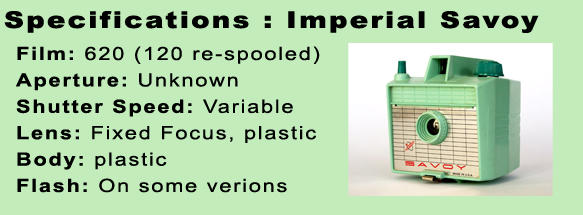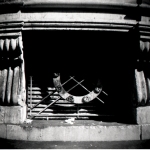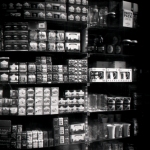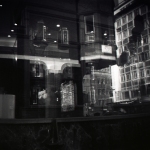Imperial Savoy
30January 28, 2012 by darl0153
The Imperial Savoy was produced between 1956 and 1965 by Chicago based Imperial Camera Corp. The Imperial Camera Corp was previously called the Herbert George Camera Co, founded by Herbert Well and George Israel in 1945, they changed their name to Imperial Camera Corp in 1961, and the Imperial Savoy was one of the first 6×6 cameras they produced under the new name.
The Savoy takes 620 roll film, giving 12 6×6 exposures. 620 film is pretty much identical to 120 film with the exception that the spool it’s wound around has thinner ends, making the roll of film shorter. It’s possible to re-spool 120 film onto a 620 spool and it’ll fit the camera fine. This can be done yourself or respooled 120 film is available on line.
The Savoy was one of the first cameras to be made in several colours, blue, tan, grey, black red (which I’m on the look out for) and green – which I have here.
Being made during the early days of the space race the Savoy is decorated with graphics of satellites and grills on the aluminium faceplate and moulded fins on the top and down the back.
The Savoy is a simple plastic box camera, the plastic lens is fixed focus and there are no exposure controls. The shutter is operated by a single spring which depending on how fast you press the shutter button depends on how fast the shutter opens and closes. The camera was also released under different names, the Mark XII Flash, Reflex, Six Twenty and Six Twenty Reflex. Some versions had a flash socket consisting of two holes on the side of the camera where a flash bulb with a dish shaped reflector would slot into
I first saw the later Savoy II in an issue of Light Leaks magazine, and fell in love with the lurid pea green colour and retro design, I tried to hunt one down, but with no success – instead I did come across the original Savoy – and this was the first camera I bought that led me to collecting more Imperial cameras, and then onto old cameras as a whole, so this little green box has a special place in my collection.
I re-spooled some 120 film and I took it out for the first time around London – see some of the results below – and it was quite hard to walk around China Town and Soho without being stopped every 20 yards by people stopping me to look at the camera, asking me where I got it, and commenting on how cute it was.
The one disadvantage I did come across was that the view finder is tiny, and only shows a small section of what you are actually photographing, I didn’t realise this until I processed the films and all the images had more in them than I had composed for, but I was still very pleased with the results, what you’d expect form a plastic lens camera, some distortion and blurring around the edges, vignetting in the corners and the occasional light leak. It’s still one of my favourite cameras, and I should use it more than I do to be honest.













What a gorgeous little minx of a camera – and what pleasing results ! I’m all for a bit of randomness with the viewfinder. Am on a hunt for one already. Thank you for sharing.
Lurid — what a great word to describe that awful green! Fun photos though.
Can you maybe help me please with my problem?
I own Savoy Imperial camera and succesfully loaded film on it and everything works fine.
I am turning knob to move to next image, so film winds to the left knob (looking from behind). Now my question is…. what should I do at the end? When I come to the last picture? Should I turn knob until film gets released or something?
Any instructions on this?
thanks for help.
Hi,
Its not like 35mm where you have to rewind the film, with 120/620 film you need to wind the whole lot, film and backing paper, onto the take up spool. Once it’s all accross open the camera and remove the film. There will be an empty spool from the film you put in, take this out and put it in the take up position ready for your next film. Hope that makes sense 🙂
THANK YOU very much for this info. I searched on the internet, but couldn’t find any info about this.
So let me get this: when I wind the whole film onto take up spool, I just open the case and take it out. Shouldn’t I be worriead about any light coming to film? Or I need to doi tin dark environment?
Really aprishiate this help. I am new to this camera and soo exited to see the results that camera will produce. 🙂
Hi,
It’s fine to open in daylight, there’s a paper backing that wraps itself around the film, you probably noticed this as you loaded the film. The film is tucked away inside this strip of paper. There will be a small strip of sticky paper (you may need to lick it to make it sticky) that you can use to stick the backing paper down with to stop it unrolling 🙂
I cant seem to find any loading instructions…looking from the back the round knob on my left the trigger on my right…do I LOAD the film for the left to the right so that when I am all done the film will all be on the trigger side?
thanks..
cindy
Hi, no, you load the film into the triger side on the right. pull the film round to the left ‘wind on knob’ side and insert the paper tab into the empty spool (you may need to take the empty spool from the right hand side, as this is where it ends up after the film is used) wind on the film until you see a long arrow , or the word ‘START’ on the backing paper then place the back of the camera back on. keep winding until you see the number ‘1’ in the small red window in the back. You’re now ready to start shooting, winding the film accros until you see the next number in the window and so on. When finished, keep winding until you see nothing in the window, and then wind a bit more just to be safe. open the back of the camera, and your exposed film should now be all on the ake up spool on the left hand side with an empty film spool on the right (which your film came on) it’s juat a matte of placing the empty spool onto the left jand side ready for your next film – hope that makes sense 🙂
Actually, if you look at the instructions I’ve posted for the Colt 44 it’s pretty much the same process – and makes a bit more snese 😀
I bought the green version while on vacation for my daughter, and was puzzled by this point. My more recent film cameras were all 35 mm, I forgot how the “no rewind” cameras worked, even though I owned more than one back in the time that they were popular! Thank you for the very clear instructions.
thank you so much….so I loaded it…I never saw the small 1 and now i am on a 3…should I just stop and shoot from this point…i was very careful to look for the 1…would there be numbers before I get to the actual REAL 1?
and they are double numbers..like two 3 stacked…
Hi, it depends on your brand of film, if you follow this link/address you should be able to see an example of backing paper – http://blog.baquephoto.com/wp-content/uploads/2010/06/120-Backing-Paper1.jpg (or if you google 120 backing paper there should be loads of examples)
Usually there will be a set of symbols, like circles, or arrows getting smaller until they get to the number. There will also be more than one of each number on the strip, this is for different camera formats, but one will appear in your window, it’s also possible for the numbers to be stacked – this depends on the possition of the red window. I would start shooting at 3, as it’s not possibel to rewind without taking out the film and doing it manually in the dark.
This was the first camera I bought. Paid 25 cents for it at a tag sale back in the early 70’s, and used it for years. I thought I put 120 film in it but it sounds like I must have put 620 in it. I no longer have the camera but was just thinking about it, and lo and behold there’s your nice write up. Thanks for the great write up and photo!
I just came across a box of vintage cameras left to me by my grandfather. Inside this box were two savoy cameras. I thought this box was worthless. I’m glad I did this research. Thanks for enlightening me!
Cool 🙂 what colours do you have? Any other gems in the box?
I just bought one of these on CL for $10 and tried to put 120 then 220 film in it. Not so smart! Im off to get 620.
Cool, you just need a 620 spool to wind 120 film on to 🙂
I just bought one of these actually. I suspect I could use 35mm film in this if taped securely, but will need to test that out. I was expecting the shutter to be a variable bulb mode type because of your description, but mine definitely has a set consistent shutter speed. To my eye it looks faster than 1/30th. Maybe around 1/60th? I can’t imagine the aperture is anything less than f8 either.
Hi, sorry for any confusion on the shutter speed, I only meant the fact that you could adjust the shutter speed by either slowly pressing the shutter or giving it a sharp quick press to make it faster, probably only makes a fraction of difference, but I did notice some difference in my photographs. You’re right about the aperture, it does look to be around f8, although it’s never been mentioned anywhere that I could find.
Fair enough. I’d say that applies to lots of cameras like this!
I just found a red one in my grandparent’s basement and had never seen/heard of the brand/model before and now I’m excited to go out and play with it!!
cool – I really like the red version as well – hope you get some good results 🙂
Hi. What iso film did you use here? Some images look a bit dark. Was it the light you think or the film?
I used HP5 (ISO 400) and it was fairly sunny that day, so I think they were slightly over exposed – so a combination of the two I think, I didn’t have any 100 film with me – I kind of like darker images though 🙂
That’s a nice little camera! I definitely want to try this out in the future! I have a Holga 120N and a Kodak Brownie Flashmite 20 that I shoot photos with and I LOVE them.
I think I just like shooting photos with plastic cameras, toy cameras and smartphones in general. It gives me a break from using my Nikon DSLR and it helps me enjoy shooting on film rolls a lot easier. Plus, the cameras are lightweight!
Thanks 🙂
I only use old film cameras. I like how it doesn’t tie you down with loads of buttons and controls. You’re more focused on the scene in front of you 🙂
I have this camera which was given to me by my great aunt in 1962 I was just a child but I remember all the pictures that had taken with it and to me they were better then the Polaroid camera and surprising they were clear. I haven’t used it in over 50 years just been moving it from shelf to shelf going to try to get some film to see if it still work.
I have several of the colored Savoy cameras in my collection and love them! This weekend, I purchased an almost identical camera in a dark grey. The plastic body is that of the Savoy, but the faceplate contains the name Nor-Way. Other markings on the faceplate are: 2 1/4 x 2 1/4–620; Made in U.S.A.; and W. T. Grant Co. It came in the original box. Because it is so close to the Savoy, I assumed it was manufactured by Imperial, but there is no indication of that. Coincidentally, my first job out of high school–before I went off to college–was at W. T. Grant Co.
Have you come across the Nor-Way or are you aware of it? I’d like to find out a little more about it.
Hi Ann,
Interesting, I had not heard of this one, I think there there was another called Nor-Flash, but not sure. I was aware of the Sears version of the Savoy, the Tower Snapper. Looks like a few companies rebadged the Savoy. I’ll have to keep an eye out for this as well now 🙂 (although finding these Imperial cameras in the U.K. is pretty rare, I only have a few) thanks for the info 🙂